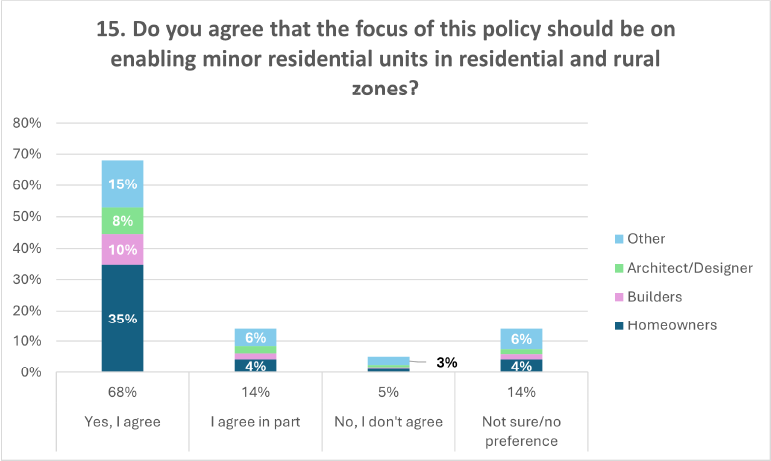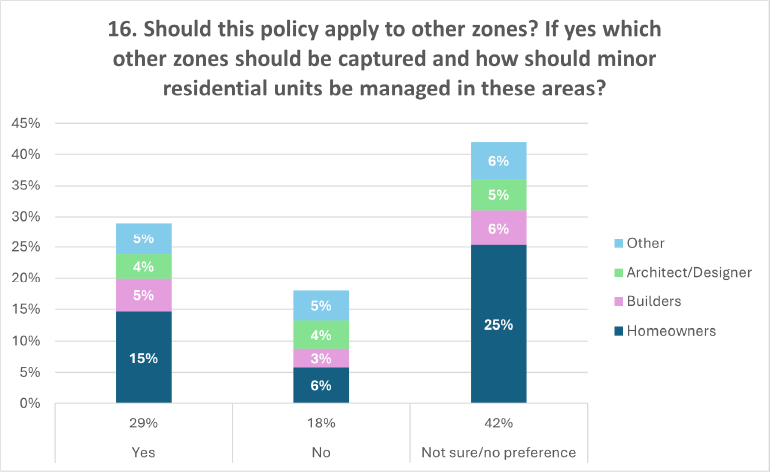Where the policy should apply
On this page I tēnei whārangi
What was proposed
The proposed focus of this policy is on enabling granny flats in rural and residential zones. In the discussion document, feedback was sought about whether policy should also apply in other appropriate zones, for example mixed-use and Māori purpose zones.
What was asked
Question 15: Do you agree that the focus of this policy should be on enabling minor residential units in residential and rural zones?
Question 16: Should this policy apply to other zones? If yes, which other zones should be captured and how should minor residential units be managed in these areas?
Figure 11: Graph detailing the response to question 15

Text description of graph - Figure 11: Graph detailing the response to question 15
Figure 12: Graph detailing the response to question 16

Text description of graph - Figure 12: Graph detailing the response to question 16
Summary of feedback
In response to questions 15 and 16, 1450 submitters responded with 323 and 375 submitters, respectively, providing a further explanation of their view.
Overall, submitters considered the policy should apply in rural and residential zones as proposed, and also in Māori purpose and mixed-use zones.
Key themes
A key theme from submissions was that the policy may not align with other government policies if it applies in medium and high-density zones and some rural zones. Enabling the policy in medium and high-density zones could result in inefficient land use and misalignment with the National Policy Statement on Urban Development (2020) and the medium density residential standards. Submitters also considered the policy will misalign with National Policy Statement on Highly Productive Land (2022) if it is applied in all rural zones.
A key risk identified by some submitters across all demographic groups is that the policy should not apply to other zones, especially industrial and commercial zones, as it could result in adverse effects such as reverse sensitivity issues and impacts on infrastructure.
Sector views
Homeowners
A key theme from many homeowner submissions was that the policy should apply ‘everywhere’ or ‘in all zones’.
Some common zones that homeowners considered the policy should apply to include all residential and rural zones (including rural lifestyle, settlement and production zones), Māori purpose zones, mixed-use zones, commercial zones, city centre zones, business zones, light industrial zones, coastal zones, zones where campgrounds are provided for, and specific zones such as the Waitākere Ranges zones.
Iwi, hapū and Māori
Iwi, hapū and Māori submitters supported this policy applying to other zones, specifically Māori purpose zones and business zones. This was because the policy will provide better social, housing and economic outcomes for Māori if it applies more broadly.
Councils
Many councils considered the policy should not apply in medium-density and high-density zones. This was because this could result in inefficient use of space and would undermine existing requirements under the medium density residential standards and the National Policy Statement on Urban Development (2020).
Some councils considered the policy should only apply to residential zones and not to rural zones. These submitters felt that enabling more development in rural zones will not meet the needs of people and communities due to lack of connection to public transport and commercial centres. There is also less infrastructure capacity in rural zones and the policy could undermine the intent of the National Policy Statement on Highly Productive Land (2022).
Some councils stated that the policy should be limited to rural and residential zones because these zones already anticipate residential activity, and enabling this policy in other zones could result in adverse effects, such as reverse sensitivity.
A few councils considered this policy should also apply to mixed-use zones as this would enable an increase of much-needed housing supply, for example in Western Bay of Plenty.
Industry
Planners, architect/designers and developers
There was support from planners and architect/designers for the focus of the policy to enable granny flats in rural and residential zones only. This was because it simplifies the policy and matches the purpose of those zones.
Developers were generally supportive of the policy applying in other zones, including coastal living zones, papakāinga zones, rural lifestyle zones, and commercial zones.
Professional organisations
Engineering New Zealand and the New Zealand Geotechnical Society considered the policy should apply to rural and residential zones only. This was due to concerns around the impact on the environment and on infrastructure.
While the New Zealand Planning Institute (NZPI) was generally opposed to this policy, it noted it may be appropriate for the policy to apply in other zones, such as settlement, Māori purpose, and mixed-use zones. NZPI considered the key criterion for whether the policy should apply in other zones is whether residential activities are already permitted in those zones.

